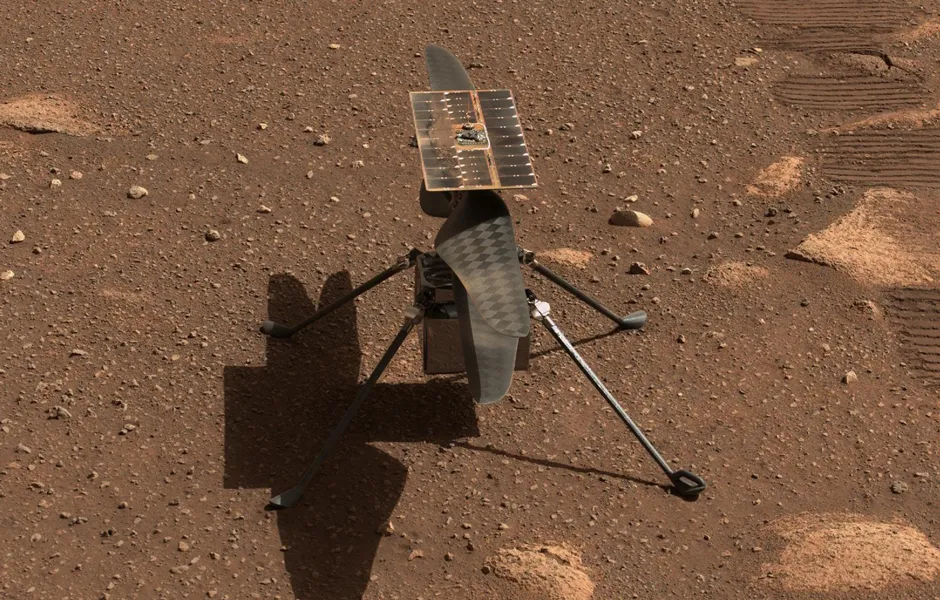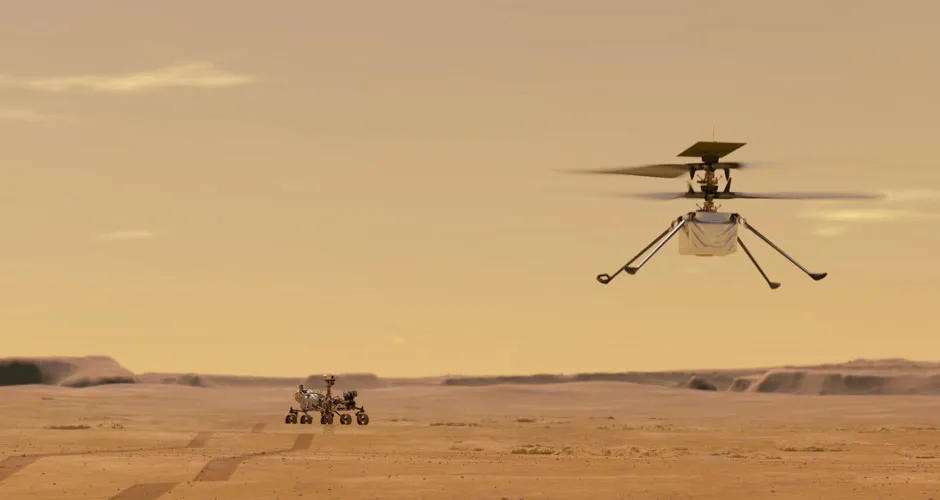Ready your countdown timers: the Ingenuity Mars helicopter is now almost ready for its first flight. The tiny rotorcraft has now been deployed from the Perseverance rover, and has been shown to withstand the Red Planet’s dangerously low temperatures (down to -90°C at night).
With Ingenuity undergoing a series of system checks, the Marscopter is expected to make its first attempt at powered, controlled flight in the coming days.
While not armed with any scientific equipment, the experimental rotorcraft could become the first vehicle to fly on another world.
Currently, all signs for this flight look good, with Ingenuity having delivered a promising first status report back to Earth: both the craft’s batteries and heating systems (used to maintain its electronics in Mars’s cold climate) are performing well.
And not only has the Ingenuity been able to take a quick snap of the Martian surface itself, but the Perseverance rover has also captured an image of the rotorcraft standing alone.

But when exactly will the Marscopter finally take to the skies? And how far will it fly? Here’s all you need to know.
When will the Ingenuity Mars helicopter fly?
The Ingenuity Mars helicopter will take flight no sooner than Sunday 11April 2021. An exact time is yet to be given.
However, NASA is planning to announce Ingenuity's first test flight results at a news conference on 12.30am PDT (8.30pm, UK time) on Monday 12 April 2021.
However, NASA say that these details could change as engineers work on Ingenuity's preflight checks.
The vehicle travelled to the Martian surface in a compartment inside the Perseverance rover. After being deployed, Ingenuity will have to successfully charge itself through solar power before attempting up to five test flights within a 31-day period.
“Once we start the deployment there is no turning back. All activities are closely coordinated, irreversible, and dependent on each other," said Farah Alibay, Mars Helicopter integration lead for the Perseverance rover.
"If there is even a hint that something isn’t going as expected, we may decide to hold off for a sol or more until we have a better idea what is going on.”
Fitted with two cameras, the helicopter is expected to transmit images (via the Perseverance rover and Deep SpaceNetwork) of its flight back to Earth.
To make more than one flight, Ingenuity must survive the extremely low temperatures of the planet’s surface (which plummets to -90°C at night outside of Perseverance's belly). The helicopter has survived this chill so far, but this doesn’t guarantee the craft won’t encounter problems in future.
What exactly is Ingenuity?
Ingenuity is a small helicopter on the Martian surface that landed alongside NASA’s Perseverance rover. While initially stored within the rover, the solar-powered vehicle will be deployed onto the Martian surface. To launch, Ingenuity will use a small helipad, also stowed in Perseverance.
While Ingenuity weighs 1.8kg on Earth, this drops to 0.68kg on Mars due to the planet's lower gravity.
The craft is equipped with two cameras, one colour with a horizon-facing view for terrain images, and one black-and-white for navigation.
In a big nod to the past, a small piece of material from the Flyer – the first plane to make a powered, controlled flight on Earth – is attached to Ingenuity. Flyer, built in 1903 by Orville and Wilbur Wright (you'll know them as the Wright brothers), covered 120 feet in 12 seconds.
The Apollo 11 crew flew a different piece of material from the Flyer to the Moon and back during their iconic mission in July 1969.
Ingenuity specifications
- Mass: 1.8kg
- Height: 50cm
- Rotor span: 1.2m
- Batteries: 6x Sony Li-ion, delivering 220W power
- Max flight time: 90s
- Max flights per day: 1
Why is the Mars helicopter called Ingenuity?
Interestingly, Ingenuity didn’t get its name from NASA. The craft got its name from Vaneeza Rupani, a school pupil from Tuscaloosa County High School in Alabama, USA. She submitted the title as part of NASA’s 'Name the Rover' contest, in which over 28,000 people competed.
"The ingenuity and brilliance of people working hard to overcome the challenges of interplanetary travel are what allow us all to experience the wonders of space exploration," Rupani wrote in her contest submission.
"Ingenuity is what allows people to accomplish amazing things, and it allows us to expand our horizons to the edges of the Universe."
What will happen during Ingenuity’s first flight?
The Martian helicopter’s first flight will be a basic one: a simple 20-30 second low-altitude hover. Ingenuity will be tasked with climbing at a speed of 1m/s to an altitude of about 3m, where it should hover for 20 seconds before descending back to ground.
“Every step we have taken since this journey began six years ago has been uncharted territory in the history of aircraft,” said Bob Balaram, Mars Helicopter chief engineer at JPL.
“And while getting deployed to the surface will be a big challenge, surviving that first night on Mars alone, without the rover protecting it and keeping it powered, will be an even bigger one.”
If successful, later flights will attempt further distances and higher altitudes. Ingenuity is capable of flying up to 90 seconds, managing 50 metres at a time (at a maximum height of 4.5m). Such a trip would use 8.75 watt-hours of power, less energy than is stored by an iPhone 12 battery.
What are Ingenuity's aims?

The Ingenuity Mars helicopter doesn’t have any specific science goals – it’s purely an experimental project.
However, as NASA’s Jet Propulsion Laboratory (JPL) says: “[Ingenuity's] performance during experimental test flights will help inform decisions relating to considering small helicopters for future Mars missions.”
Ingenuity’s flight could also help plans for future rotorcraft, such as NASA’s Dragonfly, an eight-rotor drone that will launch on a mission to Saturn's moon Titan in 2027.
How can Ingenuity fly on Mars?
Ingenuity’s first flight will be no easy feat. Although its gravity is about a third felt on our planet, Mars’s atmosphere is less than 1 per cent the density of Earth's. This means lifting off from the Martian surface will be akin to flying at 30,000m above the Earth (something never achieved by conventional helicopters).
However, NASA is hoping Ingenuity’s carbon-fibre rotors spinning at 2,400rpm will generate enough lift to make its mission a success. For comparison, most conventional helicopters on Earth employ rotor blades spinning at around 500rpm.
How will NASA control Ingenuity?

Ingenuity is designed to be largely autonomous – NASA won’t be able to control the helicopter with the likes of a joystick.
This is because of the massive distance between Mars and Earth – Ingenuity travelled over 200 million kilometres to reach the Red Planet. Due to this vast space, it takes more than 11 minutes to get a radio signal back to Earth.
Ingenuity will thus analyse sensor data and images of the terrain to stay in the air.